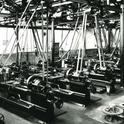Fire and Steam: a New History of Railways in Britain, by Christian Wolmar
(Atlantic, £19.99)
This magnificent book tells the tale of the railways from George Stephenson to privatisation in 300 pages. It has as much to say about politics as about the railways, and one question looms throughout: how can the nation that invented the railways and built the world's first national network have fallen so far behind much of the rest of Europe today?
The achievement of the Victorians is mind-boggling. In 1843, only 13 years after the opening of the Liverpool & Manchester railway, there were already 1,800 miles of railway in operation in Britain. In the four years of so-called "railway mania" that followed, a further 9,500 miles were authorised by parliament, fully two thirds of which were soon built, forming the backbone of today's network. Christian Wolmar calls the process "haphazard and chaotic," with little attempt by parliament—dominated by railway interests with an almost obscene lack of scruple about self-enrichment—to plan or manage the process. But the vast majority of this early phase of railway construction survives, so it can't have been too badly planned. Moreover, the one major instance of early central planning—the decision to keep overground railways out of central London—was a mixed blessing, making it impossible to run through trains across London (beyond the low capacity Snow Hill north-south route only now being upgraded as Thameslink) and thereby exacerbating to this day commuter misery and the inadequacy of efficient north-south and east-west travel within England.
Wolmar is a railway romantic, yet until it comes to British Rail he does not unduly romanticise the past. In gory detail, he describes the lives of the navvies who built the lines, the appalling safety record of the early railways, the refusal of laissez-faire parliamentarians to regulate even basic signalling properly, and the very slow running speeds of most steam trains, disguised by the glamorous time races between Scotland and London.
Nonetheless, the vision, daring and inventiveness of the Victorians shine through. Consider one further extraordinary fact: when Brunel's broad gauge was finally discarded, the Great Western converted all 213 miles west of Exeter to standard gauge in a single weekend in May 1892, with 3,400 men divided into gangs of 20, each allocated about a mile of track to convert. How long would it have taken Network Rail?
Sparks of genius persisted into the 20th century. Literally so in the case of Herbert Walker, who as general manager of the amalgamated Southern Railway for 13 years after 1924 steered through a hugely ambitious electrification programme, creating the biggest electrified suburban railway in the world. Slashing costs and journey times, and standardising running times across the whole Southern network, Walker dramatically improved service quality and passenger numbers, underpinning London's economic success to the present day. "If only the other companies had been so adventurous in electrifying their lines, Britain would have a very different railway today," Wolmar notes.
Beyond this, the 20th century is a tale of steady decline. The railways gave formidable service to the nation in both wars. The wear and tear was never properly repaired, but it was failures of policy and management that did the most damage, particularly after 1945. Virtually every government between Attlee and Major made things worse. Attlee's nationalisation was only marginally less botched than Major's privatisation; in between came 50 years of almost uninterrupted failure of strategy, investment and leadership.
Wolmar documents all this well, including the missed opportunity of the one serious national investment programme of the entire period, the 1955 "modernisation plan." Intended "to win back traffic from the roads," it completely misjudged the trends of the time, dissipating investment on 30 vast new goods marshalling yards and on new steam locomotives—both obsolete almost as soon as they were completed—when the priority ought to have been electrification of the main inter-city and commuter routes.
Wolmar's one over-romantic flourish is his panegyric on the last years of British Rail. He paints the BR of Richard Marsh and Peter Parker as a golden age, contrasting it favourably with today. While he makes some good points in relation to efficiency and the loss of engineering expertise since 1997, he otherwise recalls an entirely different British Rail to the one I knew. I remember customer service, restrictive practices and unreliability that were a national pantomime, not to mention the relentless campaign by British Rail itself for major line closures and service withdrawals long after the Beeching axe of the 1960s. Wolmar hails BR's marketing of its largely slow and unreliable inter-city services, but what I remember of the "Age of the Train" adverts was the hilarity that greeted their every appearance. It was this reality which made the railways prey to the great Tory ideological experiment of privatisation.
As head of the No 10 policy unit at the time of Railtrack's demise, I obviously believe we were right to transfer track ownership and management to a not-for-profit company. The last year of Railtrack, after the Hatfield accident and the virtual paralysis that ensued, was the lowest of all the railway's low points and—for all the continuing shortcomings—performance has improved steadily under Network Rail. Wolmar believes we should have renationalised the whole industry in 1997. Had we known what was coming, nationalisation of at least the track authority would have been sensible. But hindsight is a wonderful thing; at the time it seemed that yet more structural upheaval—simply to return to British Rail—was the last thing the industry needed. Anyway, all is not gloom. Passenger numbers are rising steadily. Many of the privatised train operators are doing a good job, and much better than British Rail. As for the "Age of the Train," it dawned for real last November with the reopening of St Pancras, grander and more nationally relevant even than in its Victorian heyday, as terminus to what is now known as "High Speed One." The big debate for the future is if and when High Speed Two and Three are to follow.
(Atlantic, £19.99)
This magnificent book tells the tale of the railways from George Stephenson to privatisation in 300 pages. It has as much to say about politics as about the railways, and one question looms throughout: how can the nation that invented the railways and built the world's first national network have fallen so far behind much of the rest of Europe today?
The achievement of the Victorians is mind-boggling. In 1843, only 13 years after the opening of the Liverpool & Manchester railway, there were already 1,800 miles of railway in operation in Britain. In the four years of so-called "railway mania" that followed, a further 9,500 miles were authorised by parliament, fully two thirds of which were soon built, forming the backbone of today's network. Christian Wolmar calls the process "haphazard and chaotic," with little attempt by parliament—dominated by railway interests with an almost obscene lack of scruple about self-enrichment—to plan or manage the process. But the vast majority of this early phase of railway construction survives, so it can't have been too badly planned. Moreover, the one major instance of early central planning—the decision to keep overground railways out of central London—was a mixed blessing, making it impossible to run through trains across London (beyond the low capacity Snow Hill north-south route only now being upgraded as Thameslink) and thereby exacerbating to this day commuter misery and the inadequacy of efficient north-south and east-west travel within England.
Wolmar is a railway romantic, yet until it comes to British Rail he does not unduly romanticise the past. In gory detail, he describes the lives of the navvies who built the lines, the appalling safety record of the early railways, the refusal of laissez-faire parliamentarians to regulate even basic signalling properly, and the very slow running speeds of most steam trains, disguised by the glamorous time races between Scotland and London.

Nonetheless, the vision, daring and inventiveness of the Victorians shine through. Consider one further extraordinary fact: when Brunel's broad gauge was finally discarded, the Great Western converted all 213 miles west of Exeter to standard gauge in a single weekend in May 1892, with 3,400 men divided into gangs of 20, each allocated about a mile of track to convert. How long would it have taken Network Rail?
Sparks of genius persisted into the 20th century. Literally so in the case of Herbert Walker, who as general manager of the amalgamated Southern Railway for 13 years after 1924 steered through a hugely ambitious electrification programme, creating the biggest electrified suburban railway in the world. Slashing costs and journey times, and standardising running times across the whole Southern network, Walker dramatically improved service quality and passenger numbers, underpinning London's economic success to the present day. "If only the other companies had been so adventurous in electrifying their lines, Britain would have a very different railway today," Wolmar notes.
Beyond this, the 20th century is a tale of steady decline. The railways gave formidable service to the nation in both wars. The wear and tear was never properly repaired, but it was failures of policy and management that did the most damage, particularly after 1945. Virtually every government between Attlee and Major made things worse. Attlee's nationalisation was only marginally less botched than Major's privatisation; in between came 50 years of almost uninterrupted failure of strategy, investment and leadership.
Wolmar documents all this well, including the missed opportunity of the one serious national investment programme of the entire period, the 1955 "modernisation plan." Intended "to win back traffic from the roads," it completely misjudged the trends of the time, dissipating investment on 30 vast new goods marshalling yards and on new steam locomotives—both obsolete almost as soon as they were completed—when the priority ought to have been electrification of the main inter-city and commuter routes.
Wolmar's one over-romantic flourish is his panegyric on the last years of British Rail. He paints the BR of Richard Marsh and Peter Parker as a golden age, contrasting it favourably with today. While he makes some good points in relation to efficiency and the loss of engineering expertise since 1997, he otherwise recalls an entirely different British Rail to the one I knew. I remember customer service, restrictive practices and unreliability that were a national pantomime, not to mention the relentless campaign by British Rail itself for major line closures and service withdrawals long after the Beeching axe of the 1960s. Wolmar hails BR's marketing of its largely slow and unreliable inter-city services, but what I remember of the "Age of the Train" adverts was the hilarity that greeted their every appearance. It was this reality which made the railways prey to the great Tory ideological experiment of privatisation.
As head of the No 10 policy unit at the time of Railtrack's demise, I obviously believe we were right to transfer track ownership and management to a not-for-profit company. The last year of Railtrack, after the Hatfield accident and the virtual paralysis that ensued, was the lowest of all the railway's low points and—for all the continuing shortcomings—performance has improved steadily under Network Rail. Wolmar believes we should have renationalised the whole industry in 1997. Had we known what was coming, nationalisation of at least the track authority would have been sensible. But hindsight is a wonderful thing; at the time it seemed that yet more structural upheaval—simply to return to British Rail—was the last thing the industry needed. Anyway, all is not gloom. Passenger numbers are rising steadily. Many of the privatised train operators are doing a good job, and much better than British Rail. As for the "Age of the Train," it dawned for real last November with the reopening of St Pancras, grander and more nationally relevant even than in its Victorian heyday, as terminus to what is now known as "High Speed One." The big debate for the future is if and when High Speed Two and Three are to follow.













